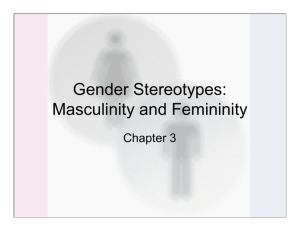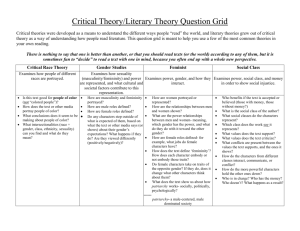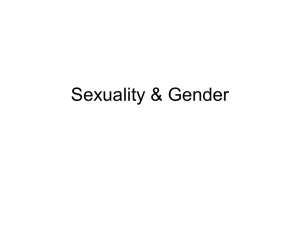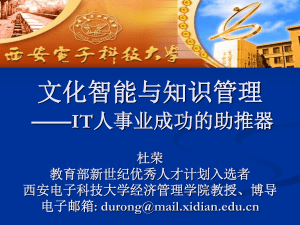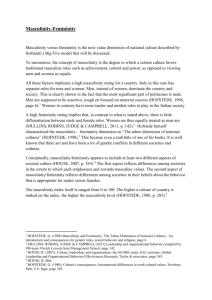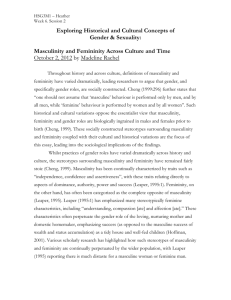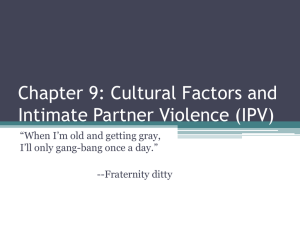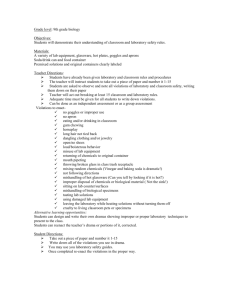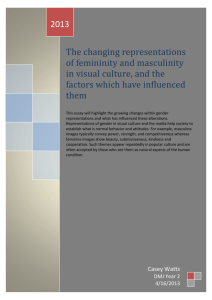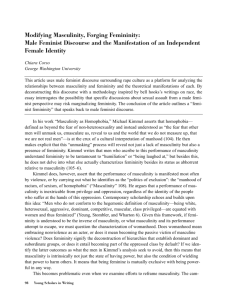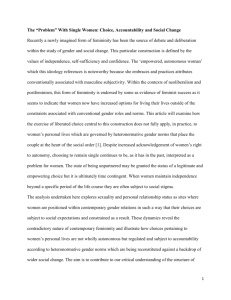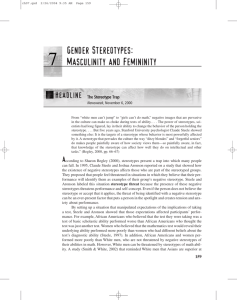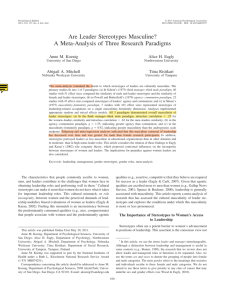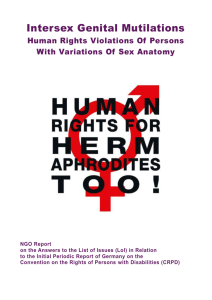Gender Expression and Human Rights
advertisement
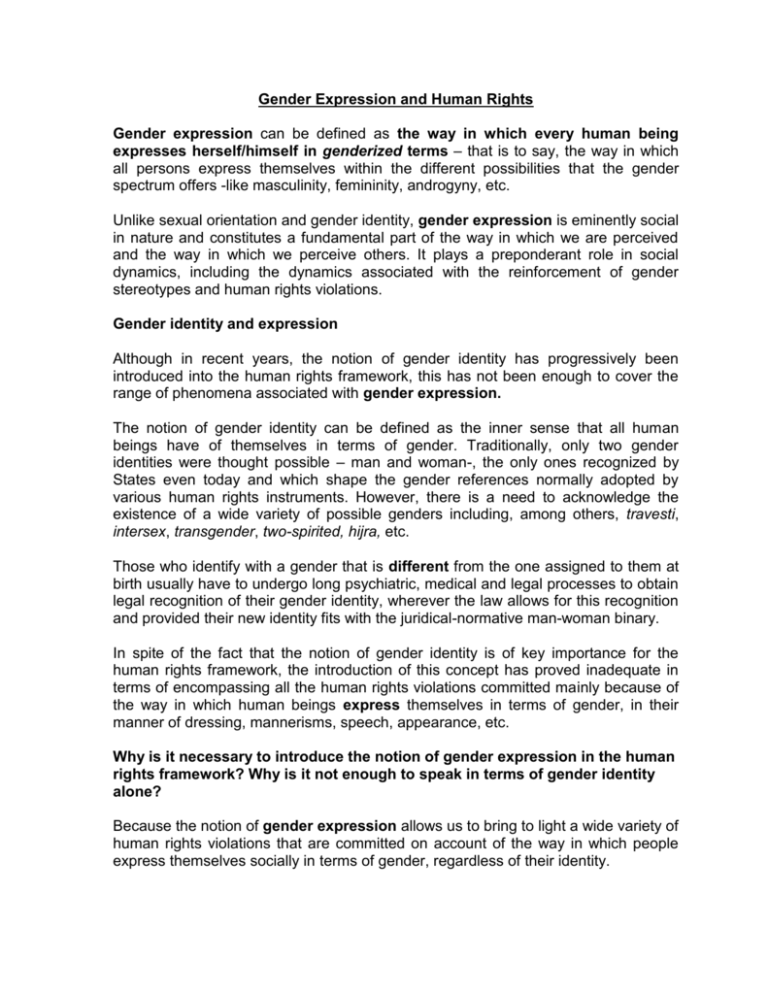
Gender Expression and Human Rights Gender expression can be defined as the way in which every human being expresses herself/himself in genderized terms – that is to say, the way in which all persons express themselves within the different possibilities that the gender spectrum offers -like masculinity, femininity, androgyny, etc. Unlike sexual orientation and gender identity, gender expression is eminently social in nature and constitutes a fundamental part of the way in which we are perceived and the way in which we perceive others. It plays a preponderant role in social dynamics, including the dynamics associated with the reinforcement of gender stereotypes and human rights violations. Gender identity and expression Although in recent years, the notion of gender identity has progressively been introduced into the human rights framework, this has not been enough to cover the range of phenomena associated with gender expression. The notion of gender identity can be defined as the inner sense that all human beings have of themselves in terms of gender. Traditionally, only two gender identities were thought possible – man and woman-, the only ones recognized by States even today and which shape the gender references normally adopted by various human rights instruments. However, there is a need to acknowledge the existence of a wide variety of possible genders including, among others, travesti, intersex, transgender, two-spirited, hijra, etc. Those who identify with a gender that is different from the one assigned to them at birth usually have to undergo long psychiatric, medical and legal processes to obtain legal recognition of their gender identity, wherever the law allows for this recognition and provided their new identity fits with the juridical-normative man-woman binary. In spite of the fact that the notion of gender identity is of key importance for the human rights framework, the introduction of this concept has proved inadequate in terms of encompassing all the human rights violations committed mainly because of the way in which human beings express themselves in terms of gender, in their manner of dressing, mannerisms, speech, appearance, etc. Why is it necessary to introduce the notion of gender expression in the human rights framework? Why is it not enough to speak in terms of gender identity alone? Because the notion of gender expression allows us to bring to light a wide variety of human rights violations that are committed on account of the way in which people express themselves socially in terms of gender, regardless of their identity. Because certain legal regulations, such as those that penalize one’s dressing in clothes of the opposite sex, or certain habitual interpretations of regulations on public scandal, prostitution and vagrancy effectively criminalize those people whose gender expression goes against the cultural stereotypes of masculinity and femininity, thus putting them in a position of social and institutional vulnerability. Because it allows the violence, often unleashed on grounds of the necessary connection that is culturally established between gender identity and gender expression, to become visible. When, for example, men are punished for their ‘feminine’ behaviour or women for their ‘masculine’ mannerisms, or when trans people who do not express their masculinity or femininity in a culturally ‘appropriate’ way are denied legal recognition of their gender identity. Because the culturally established necessary connection between gender identity and gender expression seems to morally and legally justify the surgical interventions aimed at providing an “identity” to Intersex children, when in fact these interventions are aimed at preserving and reinforcing this very connection. For instance, performing clitoridectomies as a standard practice on Intersex children is morally and legally linked with assigning them the female gender while in fact the aim is to align the gender expressed by their body with a gender identity that has been previously assigned. Because human rights violations on grounds of the gender expression of persons are closely related to gender inequalities. Where the feminine is considered inferior, while those who are legally and socially recognized as women are punished with rape, torture and murder even, if they express their gender in a ‘masculine’ way. This punishment is sometimes (but not necessarily always) related to their gender identity and their sexual orientation. Because unlike gender identity and sexual orientation, gender expression is impossible to hide. It might be argued that many human rights violations related to gender identity and/or sexual orientation are actually based on the perception of the forms of gender expression that go against the cultural stereotypes surrounding social expressions of masculinity and femininity, including the expression of love and what each human being says about herself/himself. Because in social imagery, certain forms of gender expression are not only associated with social marginality, delinquency, prostitution, the consumption and trafficking of drugs, but also seem to justify the arbitrary arrests and forced disappearances, torture or even executions. Why is gender expression a question of freedom of expression? Because it is closely related to the social dimensions of human personality and their place in daily interactions. Because individuals with certain gender expressions are subjected to openly discriminatory treatment and violence, as well as the denial of access to social spaces, free movement in public spaces, or humiliating and degrading treatment in hospitals, borders, police stations, etc. Because most of the forced surgeries performed on Intersex children are decisively linked with the capacity of each human body to clearly express certain gender standards, so that the individual’s identity may be unequivocally perceived, at first glance itself. The forcible fixing of masculinity or femininity in the bodies of human beings, by surgical and hormonal means, constitutes a clear violation of the right to freedom of expression, including the right to manifest different gender expressions through one’s body. Because for trans people, access to biotechnologies for bodily modifications – such as reconstructive surgeries and hormonal therapies- as well as the legal recognition of gender identity are subject to their ability to embody culturally stereotyped forms of masculinity and femininity, at risk of being rejected as possible candidates for medical and legal assistance. Because in the case of trans people who do not wish to modify their bodies, they are faced with the dilemma of deciding between the lack of legal recognition of their gender identity and having to undergo sterilization and genital modification surgeries. This situation not only threatens their right to bodily express different gender expressions but also forces them into trying to hide or distort their gender expression in order to survive, or suffer consequences such loss of job, harassment, imprisonment, torture or even murder when they are unable to do so. Because certain gender expressions –in particular, that of travestis, masculine lesbians and transmen- are systematically degraded by the mainstream media. Media representation of these expressions is built on ridicule, harassment and cruelty, which profoundly and negatively influence the ability of persons who embody these expressions to enjoy and express them with freedom. Because social devaluation of certain forms of gender expression restricts freedom of expression, reducing the cultural capacity to coexist with diversity, to value, respect and celebrate it. UN Resolution 2005/38 on the Right to Freedom of Opinion and Expression says that “the effective enjoyment of freedom of opinion and expression is a clear indicator of the level of protection for all other human rights and fundamental freedoms, bearing in mind that all human rights are universal, indivisible, interdependent and interconnected”. Moreover, the Resolution also refers to “human rights violations including extrajudicial executions, arbitrary detentions, torture, intimidation, harassment and persecution, threats and acts of violence and discrimination, also based on gender” that are systematically used to attack human rights defenders whose gender expression contradicts the cultural stereotypes of masculinity and femininity, in particular, travesti activists. In full agreement with the ideas expressed in this document, the Resolution “regrets that certain sections of the media are promoting false images and negative stereotypes of vulnerable individuals or groups”. For all the reasons stated above, we request the inclusion of “gender expression” as a specific cause of human rights violations, and also encourage international efforts to defend, promote and celebrate all the different modes that gender expression adopts in human beings.

